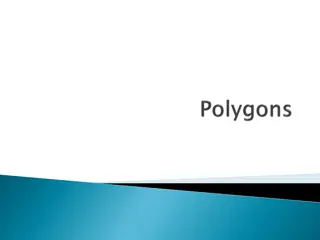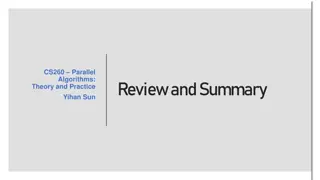Polygon Clipping Techniques and Algorithms
Polygon clipping involves modifying line-clipping procedures to achieve bounded areas after clipping. The Sutherland-Hodgman algorithm is commonly used, where polygon boundaries are processed against window edges to generate closed areas for appropriate area fill. This process involves testing for various cases based on vertex positions to determine the output vertices, resulting in a clipped polygon.
Download Presentation

Please find below an Image/Link to download the presentation.
The content on the website is provided AS IS for your information and personal use only. It may not be sold, licensed, or shared on other websites without obtaining consent from the author.If you encounter any issues during the download, it is possible that the publisher has removed the file from their server.
You are allowed to download the files provided on this website for personal or commercial use, subject to the condition that they are used lawfully. All files are the property of their respective owners.
The content on the website is provided AS IS for your information and personal use only. It may not be sold, licensed, or shared on other websites without obtaining consent from the author.
E N D
Presentation Transcript
MODULE 4 POLYGON CLIPPING KEERTHI KRISHNAN Associate Professor MEC
POLYGON CLIPPING To clip polygons, we need to modify the line-clipping procedures. A polygon boundary processed with a line clipper may be displayed as a series of unconnected line segments, depending on the orientation of the polygon to the clipping window.
POLYGON CLIPPING What we really want to display is a bounded area after clipping. For polygon clipping, we require an algorithm that will generate one or more closed areas that are then scan converted for the appropriate area fill. The output of a polygon clipper should be a sequence of vertices that defines the clipped polygon boundaries.
SUTHERLAND-HODGEMAN POLYGON CLIPPING A Polygon can be clipped by processing the polygon boundary as a whole against each window edge. This could be accomplished by processing all polygon vertices against each clip rectangle boundary in turn. Beginning with the initial set of polygon vertices, we could first clip the polygon against the left rectangle boundary to produce a new sequence of vertices. The new set of vertices could then be successively passed to a right boundary clipper, a bottom boundary clipper, and a top boundary clipper. At each step, a new sequence of output vertices is generated and passed to the next window boundary clipper.
SUTHERLAND-HODGEMAN POLYGON CLIPPING There are four possible cases when processing vertices in sequence around the perimeter of a polygon. As each pair of adjacent polygon vertices is passed to a window boundary clipper, we make the following tests: (1) If the first vertex is outside the window boundary and the second vertex is inside, both the intersection point of the polygon edge with the window boundary and the second vertex are added to the output vertex list. (2) If both input vertices are inside the window boundary, only the second vertex is added to the output vertex list. (3) lf the first vertex is inside the window boundary and the second vertex is outside, only the edge intersection with the window boundary is added to the output vertex list. (4) If both input vertices are outside the window boundary, nothing is added to the output list.
MODULE IV Polygon clipping-Sutherland Hodgeman algorithm, Weiler- Atherton algorithm, Three dimensional object representation- Polygon surfaces, Quadric surfaces Basic 3D transformations POLYGON CLIPPING To clip polygons, we need to modify the line-clipping procedures. A polygon boundary processed with a line clipper may be displayed as a series of unconnected line segments, depending on the orientation of the polygon to the clipping window. Convex polygons are correctly clipped by the Sutherland-Hodgeman algorithm, but concave polygons may be displayed with extraneous lines. This occurs when the clipped polygon should have two or more separate sections. But since there is only one output vertex list, the last vertex in the list is always joined to the first vertex .
Weiler- Atherton Polygon Clipping This clipping procedure was developed as a method for identifying visible surfaces, and so it can be applied with arbitrary polygon-clipping regions. The basic idea in this algorithm is that instead of always proceeding around the polygon edges as vertices are processed, we sometimes want to follow the window boundaries. Which path we follow depends on the polygon-processing direction (clockwise or counter clockwise) and whether the pair of polygon vertices currently being processed represents an outside-to-inside pair or an inside- to-outside pair. For clockwise processing of polygon vertices, we use the following rules: For an outside-to-inside pair of vertices, follow the polygon boundary. For an inside-to-outside pair of vertices,. follow the window boundary in a clockwise direction. In the below Fig. the processing direction in the Weiler-Atherton algorithm and the resulting clipped polygon is shown for a rectangular clipping window
Representation schemes for solid objects are divided into two categories as follows: 1. Boundary Representation ( B-reps) It describes a three dimensional object as a set of surfaces that separate the object interior from the environment. Examples are polygon facets and spline patches. 2. Space Partitioning representation It describes the interior properties, by partitioning the spatial region containing an object into a set of small, nonoverlapping, contiguous solids(usually cubes). Eg: Octree Representation
Polygon Surfaces Polygon surfaces are boundary representations for a 3D graphics object is a set of polygons that enclose the object interior. Polygon Tables The polygon surface is specified with a set of vertex coordinates and associated attribute parameters. For each polygon input, the data are placed into tables that are to be used in the subsequent processing. Polygon data tables can be organized into two groups: Geometric tables and attribute tables. Geometric Tables Contain vertex coordinates and parameters to identify the spatial orientation of the polygon surfaces. Attribute tables Contain attribute information for an object such as parameters specifying the degree of transparency of the object and its surface reflectivity and texture characteristics.
A convenient organization for storing geometric data is to create three lists: 1. The Vertex Table Coordinate values for each vertex in the object are stored in this table. 2. The Edge Table It contains pointers back into the vertex table to identify the vertices for each polygon edge. 3. The Polygon Table It contains pointers back into the edge table to identify the edges for each polygon. This is shown in fig Three Dimensional Transformations Geometric transformations in three dimensions are extended from two-dimensional methods by including considerations for the z-coordinate.
ROTATION To generate a rotation transformation for an object, we must designate an axis of rotation (about which the object is to be rotated) and the amount of angular rotation. Unlike two-dimensional applications, where all transformations are carried out in the xy plane, a three-dimensional rotation can be specified around any line in space. Coordinate-Axes Rotations The two-dimensional z-axis rotation equations are easily extended to three dimensions:
Then we swing u around to the z axis using a y-axis rotation. These two rotations are illustrated in Fig. 11-12 for one possible orientation of vector u. Since rotation calculations involve sine and cosine functions, the standard vector operations can be used to obtain elements of the two rotation matrices. Dot-product operations allow us to determine the cosine terms, and vector cross products provide a means for obtaining the sine terms. We establish the transformation matrix for rotation around the x axis by determining the values for the sine and cosine of the rotation angle necessary to get u into the xz plane. This rotation angle is the angle between the projection of u in the yz plane and the positive z axis. If we designate the projection of u in the yz plane as the vector u' = (0, b, c), then the cosine of the rotation angle can be determined from the dot product of u' and theunit vector uz, along the z axis: This matrix rotates unit vector u about the x axis into the xz plane. Next, determine the transformation matrix that will swing the unit vector in the xz plane counterclockwise around the y axis onto the positive zaxis. Here, the vector, labeled u" is orientation of the unit vector in the xz plane (after rotation about the x axis) . This vector, labeled u", has the value a for its x component, since rotation about the axis leaves the component unchanged. Its























